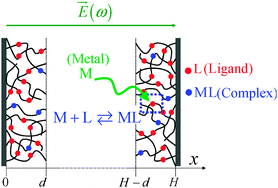We report a comprehensive formalism for the dynamics of metal speciation across an interphase formed between a complexing soft film layer and an electrolyte solution containing indifferent ions and metal ions that form complexes with charged molecular ligands distributed throughout the film. The analysis integrates the intricate interplay between metal complexation kinetics and diffusive metal transfer from/toward the ligand film, together with the kinetics of metal electrostatic partitioning across the film/solution interphase. This partitioning is determined by the settling dynamics of the interfacial electric double layer (EDL), as governed by time-dependent conduction–diffusion transports of both indifferent and reactive metal ions. The coupling between such chemodynamic and electrodynamic processes is evaluated via derivation of the dielectric permittivity increment for the ligand film/electrolyte interphase that is perturbed upon application of an ac electric field (pulsation ω) between electrodes supporting the films. The dielectric response is obtained from the ω-dependent distributions of all ions across the ligand film, as ruled by coupled Poisson–Nernst–Planck equations amended for a chemical source term involving the intra-film complex formation and dissociation pulsations (ωa and ωd respectively). Dielectric spectra are discussed for bare and film coated-electrodes over a wide range of field pulsations and Deborah numbers De = ωa,d/ωdiff, where ωdiff is the electric double layer relaxation pulsation. The frequency-dependent dynamic or inert character of the formed metal complexes is then addressed over a time window that ranges from transient to fully relaxed EDL. The shape and magnitude of the dielectric spectra are further shown to reflect the lability of dynamic complexes, i.e. whether the overall speciation process at a given pulsation ω is primarily rate-limited either by complexation kinetics or by ion-transport dynamics. The limits, strengths and extensions of the approach are further discussed within the context of metal speciation dynamics at soft planar and particulate complexing interphases.

You have access to this article
 Please wait while we load your content...
Something went wrong. Try again?
Please wait while we load your content...
Something went wrong. Try again?


 Please wait while we load your content...
Please wait while we load your content...